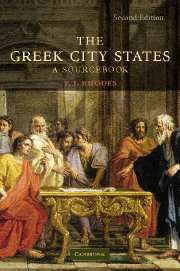123 results
4 - Thucydides’ Use of Evidence and Sources
- from Part I - Context and Method
-
-
- Book:
- The Cambridge Companion to Thucydides
- Published online:
- 02 March 2023
- Print publication:
- 09 March 2023, pp 50-62
-
- Chapter
- Export citation
Atomic Resolution Imaging of Dislocations in AlGaN and the Efficiency of UV LEDs
-
- Journal:
- Microscopy and Microanalysis / Volume 24 / Issue S1 / August 2018
- Published online by Cambridge University Press:
- 01 August 2018, pp. 4-5
- Print publication:
- August 2018
-
- Article
-
- You have access
- Export citation
The dwarf galaxy population as revealed by ALFALFA
-
- Journal:
- Proceedings of the International Astronomical Union / Volume 14 / Issue S344 / August 2018
- Published online by Cambridge University Press:
- 30 October 2019, pp. 464-467
- Print publication:
- August 2018
-
- Article
-
- You have access
- Export citation
Neutron diffraction at simultaneous high temperatures and pressures, with measurement of temperature by neutron radiography
-
- Journal:
- Mineralogical Magazine / Volume 65 / Issue 6 / December 2001
- Published online by Cambridge University Press:
- 05 July 2018, pp. 737-748
-
- Article
- Export citation
A randomized controlled trial of in-patient treatment for anorexia nervosa in medically unstable adolescents
-
- Journal:
- Psychological Medicine / Volume 45 / Issue 2 / January 2015
- Published online by Cambridge University Press:
- 14 July 2014, pp. 415-427
-
- Article
-
- You have access
- Open access
- HTML
- Export citation
Contributors
-
-
- Book:
- Geriatric Emergency Medicine
- Published online:
- 05 January 2014
- Print publication:
- 16 January 2014, pp vii-x
-
- Chapter
- Export citation
The Organization of Athenian Public Finance*
-
- Journal:
- Greece & Rome / Volume 60 / Issue 2 / October 2013
- Published online by Cambridge University Press:
- 16 September 2013, pp. 203-231
- Print publication:
- October 2013
-
- Article
- Export citation
Acinetobacter bacteraemia in Thailand: evidence for infections outside the hospital setting
-
- Journal:
- Epidemiology & Infection / Volume 142 / Issue 6 / June 2014
- Published online by Cambridge University Press:
- 04 September 2013, pp. 1317-1327
-
- Article
-
- You have access
- HTML
- Export citation
THE DIONYSIA AND DEMOCRACY AGAIN*
-
- Journal:
- The Classical Quarterly / Volume 61 / Issue 1 / May 2011
- Published online by Cambridge University Press:
- 04 May 2011, pp. 71-74
- Print publication:
- May 2011
-
- Article
-
- You have access
- Export citation
Contributors
-
-
- Book:
- The Cambridge Dictionary of Christianity
- Published online:
- 05 August 2012
- Print publication:
- 20 September 2010, pp xi-xliv
-
- Chapter
- Export citation
Temporal changes in the frequencies of the solar p-mode oscillations during solar cycle 23
-
- Journal:
- Proceedings of the International Astronomical Union / Volume 6 / Issue S273 / August 2010
- Published online by Cambridge University Press:
- 26 August 2011, pp. 389-393
- Print publication:
- August 2010
-
- Article
-
- You have access
- Export citation
Central Greece in the Fourth Century - (J.) Buckler, (H.) Beck Central Greece and the Politics of Power in the Fourth Century B. C. Pp. xx + 309, maps. Cambridge: Cambridge University Press, 2008. Cased, £55 US$99. ISBN: 978-0-521-83705-7.
-
- Journal:
- The Classical Review / Volume 60 / Issue 1 / April 2010
- Published online by Cambridge University Press:
- 08 March 2010, pp. 181-183
- Print publication:
- April 2010
-
- Article
- Export citation
Studies of elemental composition as a biological marker in insects. II. The elemental composition of apterae of Rhopalosiphum padi (L.) and Metopolophium dirhodum (Walker) (Hemiptera: Aphididae) from different soils and host-plants
-
- Journal:
- Bulletin of Entomological Research / Volume 75 / Issue 1 / March 1985
- Published online by Cambridge University Press:
- 10 July 2009, pp. 107-120
-
- Article
- Export citation
State and Religion in Athenian Inscriptions*
-
- Journal:
- Greece & Rome / Volume 56 / Issue 1 / April 2009
- Published online by Cambridge University Press:
- 09 March 2009, pp. 1-13
- Print publication:
- April 2009
-
- Article
-
- You have access
- Export citation
2 - Making and breaking treaties in the Greek world
-
-
- Book:
- War and Peace in Ancient and Medieval History
- Published online:
- 09 August 2009
- Print publication:
- 13 March 2008, pp 6-27
-
- Chapter
- Export citation
Contents
-
- Book:
- The Greek City States
- Published online:
- 05 June 2012
- Print publication:
- 26 April 2007, pp v-vii
-
- Chapter
- Export citation
Map 1 - The Greek World
-
- Book:
- The Greek City States
- Published online:
- 05 June 2012
- Print publication:
- 26 April 2007, pp xii-xii
-
- Chapter
- Export citation
Preface to the First Edition
-
- Book:
- The Greek City States
- Published online:
- 05 June 2012
- Print publication:
- 26 April 2007, pp ix-x
-
- Chapter
- Export citation
7 - Economic Life
-
- Book:
- The Greek City States
- Published online:
- 05 June 2012
- Print publication:
- 26 April 2007, pp 181-197
-
- Chapter
- Export citation

The Greek City States
- A Source Book
-
- Published online:
- 05 June 2012
- Print publication:
- 26 April 2007



